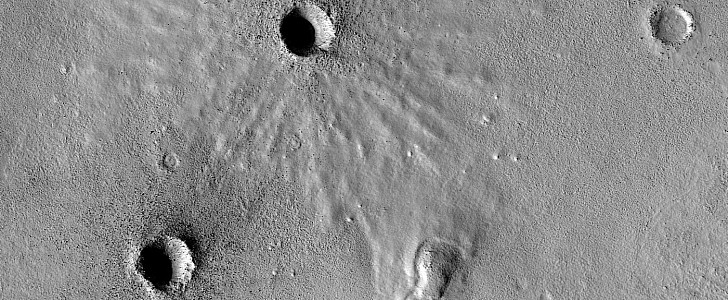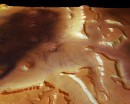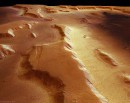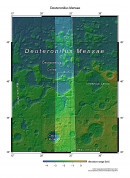On average, an asteroid impacts Earth at speeds of 40,000 mph (64,300 kph), but there are moments when the speed is much higher. And it may be even higher on Mars, a planet that has little atmosphere (it is 100 times thinner than that of our planet) to slow the pieces of falling rock down.
Given how the place also lacks any surface liquid water or vegetation to soften the blow even in the slightest, Mars is literally riddled with impact craters of various shapes and sizes, each resembling something else to the observer here on Earth.
Take these two craters, located in the Deuteronilus Mensae area of the planet, the same region where we humans uncovered the unusual hanging crater we talked about last week.
As seen from an altitude of 302 km (188 miles), where the HiRISE camera was when it snapped this pic, the two seem like bullet holes in a wall to the prone-to-trickery human eye. What’s also unusual, and a testimony to the Solar System’s aim, is how close together the two appear to be.
The people over at NASA and the University of Arizona, who are in charge of running HiRISE, don’t say much about the pic, except for the mention we’re dealing with geologically young craters (no exact time frame is given), but also relatively small ones (again, no info on scale).
Although they may seem unimportant in the grand scheme of things, the two relatively recent and comparable in size impact craters paint a picture of how dangerous the planet was (and may still be), acting as a magnet for the rocks that might have otherwise found some other place to crash.
And with accelerating plans to send human missions there, learning as much about the place as possible can only help us do that in a safe manner.
Take these two craters, located in the Deuteronilus Mensae area of the planet, the same region where we humans uncovered the unusual hanging crater we talked about last week.
As seen from an altitude of 302 km (188 miles), where the HiRISE camera was when it snapped this pic, the two seem like bullet holes in a wall to the prone-to-trickery human eye. What’s also unusual, and a testimony to the Solar System’s aim, is how close together the two appear to be.
The people over at NASA and the University of Arizona, who are in charge of running HiRISE, don’t say much about the pic, except for the mention we’re dealing with geologically young craters (no exact time frame is given), but also relatively small ones (again, no info on scale).
Although they may seem unimportant in the grand scheme of things, the two relatively recent and comparable in size impact craters paint a picture of how dangerous the planet was (and may still be), acting as a magnet for the rocks that might have otherwise found some other place to crash.
And with accelerating plans to send human missions there, learning as much about the place as possible can only help us do that in a safe manner.







